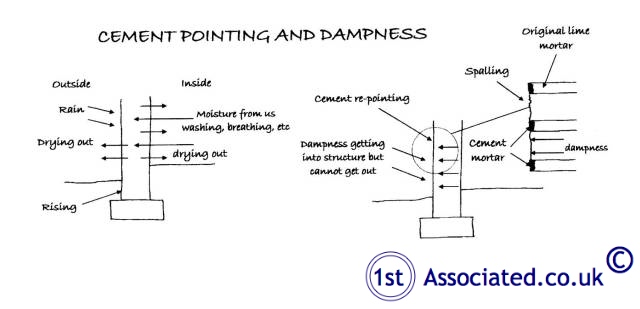How do older properties keep dry
without a damp proof course?
Our Independent Surveyors carry out Residential and Commercial Building Surveys also known as Structural Surveys, plus Home Buyers Reports. We also offer Specific Defects Reports (often referred to as Engineers Reports or Damp Reports).
We can also carry out Independent Valuations: note, these are not for bank lending but are to advise you how much we feel the property is really worth.
If you have a property problem we may even already have written an article on it and we would refer you to the many articles we have on our website.
Our independent surveyors are more than happy to chat and offer advice, so please Free phone us on 0800 298 5424 and a surveyor will call you back.
Free phone 0800 298 5424
How do older properties keep dry?
We will define older properties as those before the 1940's. Generally, these have a solid outer wall, by this we mean a nine inch or thirteen inch thick brick wall, that runs continuously from the outside to the inside, where there is then a plaster finish. The outer part of the wall gets wet and damp and then dries off in due course, with the water simply evaporating out of the wall. In some cases, the original lime mortar was replaced with a cement mortar. This stops the rainwater dissipating from the mortar joints and forces it to dissipate from the brick, which can cause the face to deteriorate.

Efflorescence
Sometimes you will get efflorescence, which are white salts that remain in the walls once the water has evaporated.
So, why do so many old building have damp proof courses inserted if they keep dry without a damp proof course?
This is a very good question. The industry sprung up around the needs of the mortgage industry. Mortgage companies, rightly so, from their building society background, required an independent inspection of the property:
1) to check it was there!
2) to check that they were lending about the right amount of money on it, and
3) to check there were no basic problems with it.
This was okay in years gone by when the independent checker was a local surveyor, who usually worked for themselves, or a small private practice, and took the time to look at the property properly. However, over the years many mortgage companies and estate agents have built up these small surveying practices until there are now some very large national surveying practices, that do nothing else but value for mortgage purposes. As these companies are interlinked with the mortgage companies and the estate agents it is very important that the mortgages are passed and approved, as there is a lot of commission to be made from a mortgage, not only on the initial sale but for years to come.
Having a damp proof course that wasn't necessary did solve the problem of getting a mortgage
 It has to be said that, whilst the damp proof wasn't necessary, it did solve a few problems. It solved the problem that the mortgage company valuer had that he had dampness using a damp meter and therefore was concerned that the mortgage company weren't for always buying a problem property and it solved the mortgage company's problem, as they wished to give a mortgage to the people purchasing the property, as that is how they make their money, and of course it gave a fantastic business to the damp proofing companies, who knew that as long as properties sold they would be forever putting in damp proof courses. Properties do sell quite frequently, generally every three to seven years.
It has to be said that, whilst the damp proof wasn't necessary, it did solve a few problems. It solved the problem that the mortgage company valuer had that he had dampness using a damp meter and therefore was concerned that the mortgage company weren't for always buying a problem property and it solved the mortgage company's problem, as they wished to give a mortgage to the people purchasing the property, as that is how they make their money, and of course it gave a fantastic business to the damp proofing companies, who knew that as long as properties sold they would be forever putting in damp proof courses. Properties do sell quite frequently, generally every three to seven years.
Emperor's new clothes
The only real problem was that the damp proofing didn't actually work! Or was this a problem, as it meant that the damp proofing companies could just add the damp proof courses in again and again and again. This really is like the Emperor's New Clothes.
The solution didn't make sense
We have no idea who was the first surveyor to say that this doesn't make sense, but we do know that over 20 years ago, when we were training, we were taught that it didn't make sense, yet here we are, some 20 years later, with the industry still working happily away.
In times gone by there has been research on this, but it was not until recently, when properties had more prominence on the television and with the media in general, that it is becoming more common knowledge and with us being called in to solve the real problems.
So, what are the real problems?
 Fairly typically, the real reason that dampness is getting into the properties is due to leaking, or wrongly placed, gutters and downpipes, so that the water literally is missing the guttering. Alternatively, it can be getting in around windows, this can allow water into the structure, which is then trapped in if the wall has been built in a cement mortar. Also, very commonly, is a high ground level and we have also heard of problems, such as burst pipes within the walls, both internal and external and of leaking radiators, but we have not personally come across these problems. Most commonly, it is a combination of many of the items that we have just mentioned. Sadly, these problems can be made worse by the cement pointing that has been carried out on the outside of the property, or the hard plaster internally, often known as a renovating plaster.
Fairly typically, the real reason that dampness is getting into the properties is due to leaking, or wrongly placed, gutters and downpipes, so that the water literally is missing the guttering. Alternatively, it can be getting in around windows, this can allow water into the structure, which is then trapped in if the wall has been built in a cement mortar. Also, very commonly, is a high ground level and we have also heard of problems, such as burst pipes within the walls, both internal and external and of leaking radiators, but we have not personally come across these problems. Most commonly, it is a combination of many of the items that we have just mentioned. Sadly, these problems can be made worse by the cement pointing that has been carried out on the outside of the property, or the hard plaster internally, often known as a renovating plaster.
What can I do other than call in a damp proof specialist, if that is what the mortgage company has recommended?
You can telephone us. We believe we are more than damp proof specialists! Typically, a course to become a member of the BWPDA takes a week or so, whereas, a course to become a surveyor takes seven years (although we do look at few other things other than dampness). We would be more than happy to come round.
However, there is no such thing as a free meal
Please note that we will charge you for our visit. You can see examples of our reports at the end of this article. We won't give a free report like the damp proofing companies, but equally we won't be recommending ourselves to come and carry out works for several thousand pounds, as is typically the case!
Condensation
Resolving Dampness in your Basement
Dampness in Buildings - Basics Article
Dampness in Buildings - Technical Article
Dampness Defects Report
Dampness Problems
Condensation Problems
Damp Walls
Shared Freehold and Problems with Damp
Damp proof courses defined
Damp Proof Courses - What are these for?
Damp Proof Specialists - Talk to us First
French Drains
Rising Damp and Independent Reports
Please see our section on:
Specific Defects Reports
If you truly do want an independent expert opinion from a surveyor with regard to structural surveys, building surveys, structural reports, engineers reports, specific defects reports, such as advising you on dampness, cracks in your property, woodworm, wet rot and dry rot. For a friendly chat call 0800 298 5424.
If you have a commercial property, be it leasehold or freehold, then you may wish to look at our Dilapidations Website at www.DilapsHelp.com and for Disputes go to our Disputes Help site www.DisputesHelp.com .
We hope you found the article of use and if you have any experiences that you feel should be added to this article that would benefit others, or you feel that some of the information that we have put is wrong then please do not hesitate to contact us (we are only human).
The contents of the website are for general information only and is not intended to be relied upon for specific or general decisions. Appropriate independent professional advice should be paid for before making such a decision.
All rights are reserved the contents of the website are not to be reproduced or transmitted in any form in whole or part without the express written permission of www.1stAssociated.co.uk.
If you require any information about Dampness in Properties please telephone us for help and advice 0800 298 5424

